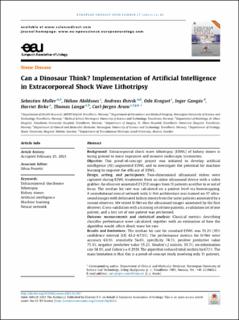| dc.contributor.author | Muller, Sebastien | |
| dc.contributor.author | Abildsnes, Håkon | |
| dc.contributor.author | Østvik, Andreas | |
| dc.contributor.author | Kragset, Oda | |
| dc.contributor.author | Gangås, Inger Sofie Hovd | |
| dc.contributor.author | Birke, Harriet | |
| dc.contributor.author | Langø, Thomas | |
| dc.contributor.author | Arum, Carl-Jørgen | |
| dc.date.accessioned | 2021-10-26T13:28:34Z | |
| dc.date.available | 2021-10-26T13:28:34Z | |
| dc.date.created | 2021-06-19T09:53:31Z | |
| dc.date.issued | 2021 | |
| dc.identifier.citation | European Urology Open Science. 2021, 27 33-42. | en_US |
| dc.identifier.issn | 2666-1691 | |
| dc.identifier.uri | https://hdl.handle.net/11250/2825773 | |
| dc.description.abstract | Background: Extracorporeal shock wave lithotripsy (ESWL) of kidney stones is losing ground to more expensive and invasive endoscopic treatments. Objective: This proof-of-concept project was initiated to develop artificial intelligence (AI)-augmented ESWL and to investigate the potential for machine learning to improve the efficacy of ESWL. Design, setting, and participants: Two-dimensional ultrasound videos were captured during ESWL treatments from an inline ultrasound device with a video grabber. An observer annotated 23 212 images from 11 patients as either in or out of focus. The median hit rate was calculated on a patient level via bootstrapping. A convolutional neural network with U-Net architecture was trained on 57 ultrasound images with delineated kidney stones from the same patients annotated by a second observer. We tested U-Net on the ultrasound images annotated by the first observer. Cross-validation with a training set of nine patients, a validation set of one patient, and a test set of one patient was performed. Outcome measurements and statistical analysis: Classical metrics describing classifier performance were calculated, together with an estimation of how the algorithm would affect shock wave hit rate. Results and limitations: The median hit rate for standard ESWL was 55.2% (95% confidence interval [CI] 43.2–67.3%). The performance metrics for U-Net were accuracy 63.9%, sensitivity 56.0%, specificity 74.7%, positive predictive value 75.3%, negative predictive value 55.2%, Youden’s J statistic 30.7%, no-information rate 58.0%, and Cohen’s k 0.2931. The algorithm reduced total mishits by 67.1%. The main limitation is that this is a proof-of-concept study involving only 11 patients. Conclusions: Our calculated ESWL hit rate of 55.2% (95% CI 43.2–67.3%) supports findings from earlier research. We have demonstrated that a machine learning algorithm trained on just 11 patients increases the hit rate to 75.3% and reduces mishits by 67.1%. When U-Net is trained on more and higher-quality annotations, even better results can be expected. Patient summary: Kidney stones can be treated by applying shockwaves to the outside of the body. Ultrasound scans of the kidney are used to guide the machine delivering the shockwaves, but the shockwaves can still miss the stone. We used artificial intelligence to improve the accuracy in hitting the stone being treated. | en_US |
| dc.language.iso | eng | en_US |
| dc.publisher | Elsevier | en_US |
| dc.relation.uri | https://www.sciencedirect.com/science/article/pii/S2666168321000525 | |
| dc.rights | Navngivelse 4.0 Internasjonal | * |
| dc.rights.uri | http://creativecommons.org/licenses/by/4.0/deed.no | * |
| dc.title | Can a Dinosaur Think? Implementation of Artificial Intelligence in Extracorporeal Shock Wave Lithotripsy | en_US |
| dc.type | Peer reviewed | en_US |
| dc.type | Journal article | en_US |
| dc.description.version | publishedVersion | en_US |
| dc.source.pagenumber | 33-42 | en_US |
| dc.source.volume | 27 | en_US |
| dc.source.journal | European Urology Open Science | en_US |
| dc.identifier.doi | https://doi.org/10.1016/j.euros.2021.02.007 | |
| dc.identifier.cristin | 1916911 | |
| cristin.ispublished | true | |
| cristin.fulltext | original | |
| cristin.qualitycode | 1 | |

